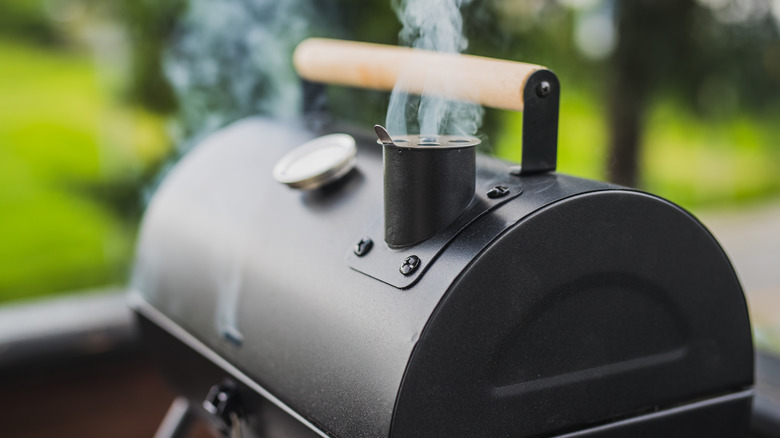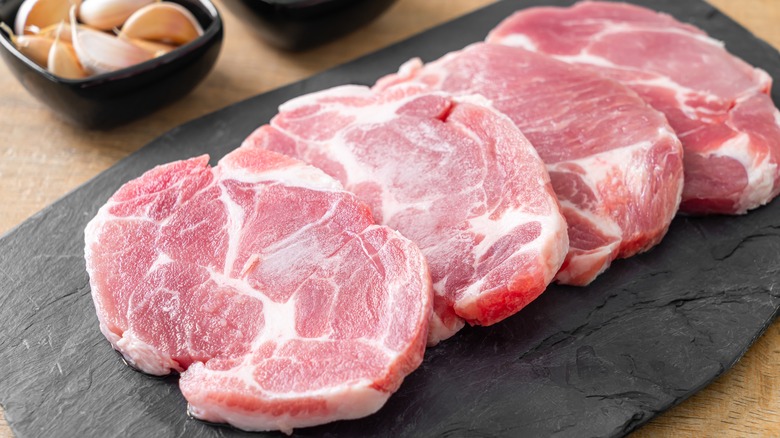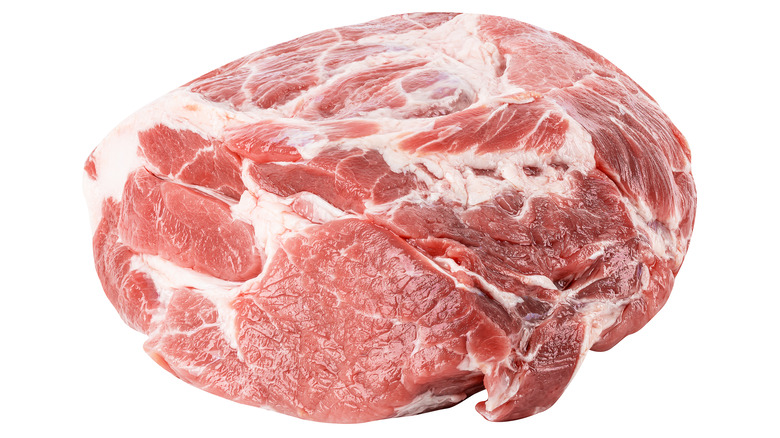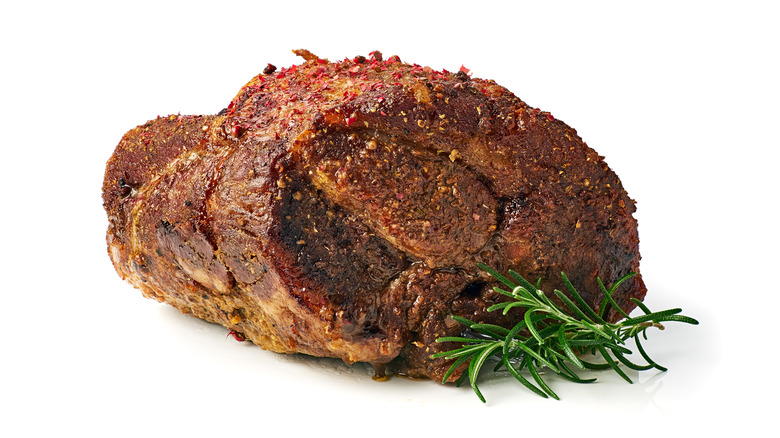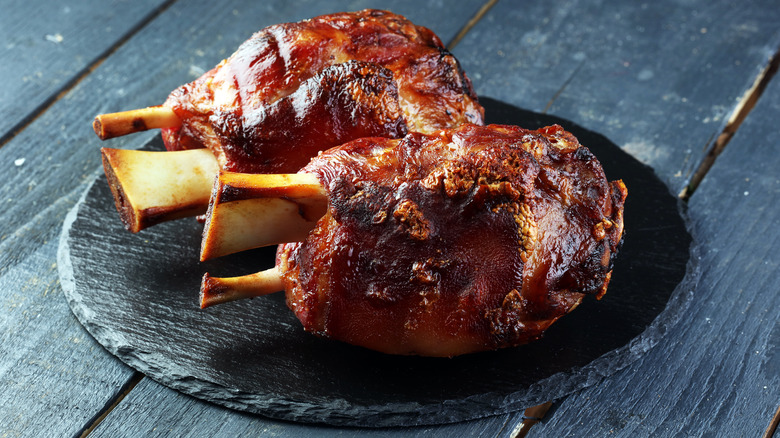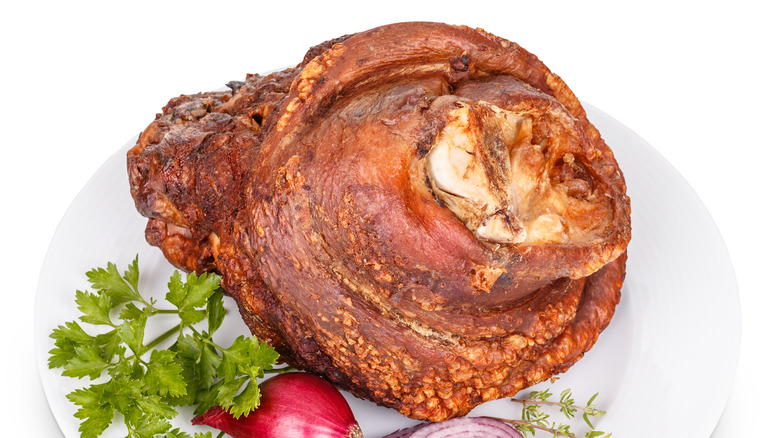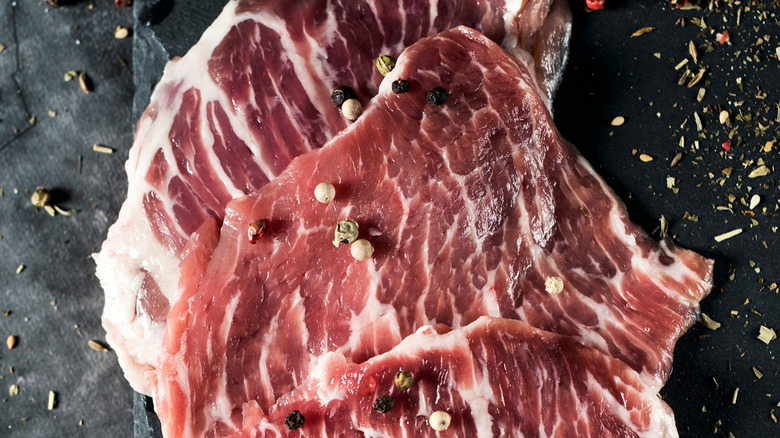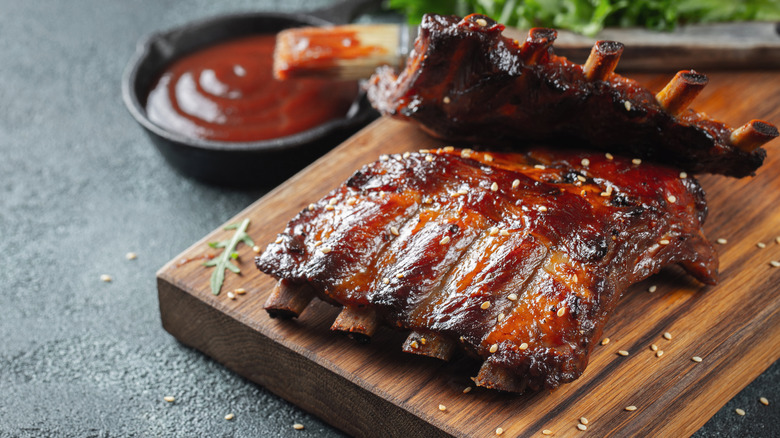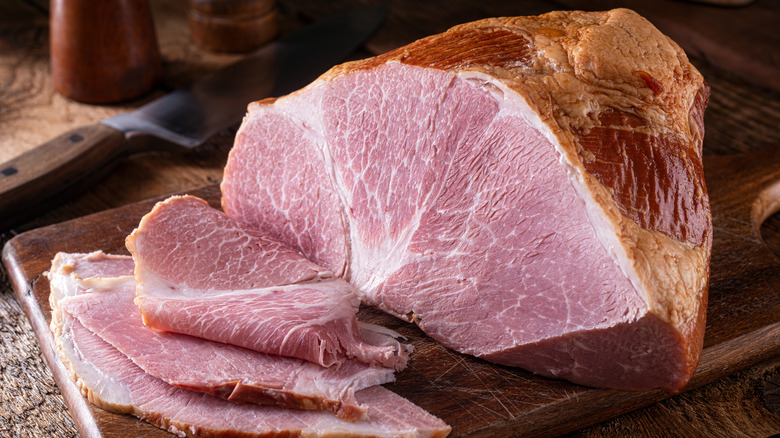The Absolute Best Cuts Of Pork To Smoke
While the never-ending debate about what constitutes barbecue vs. merely grilling takes many sides (and sauces), there's a central point that everyone can agree on: qualified barbecue is smoked meat, cooked low and slow. And it's hard to think of a meat that takes to a hot smoke at a low temperature better than pork, which is abundant with fat and strong connective tissue — although as with any animal, some cuts benefit from the process more than others.
So while there may be more than one way to skin a cat, there are even more styles of butchering a hog, and they pay dividends when subjected to a slow smoke, provided you cook each cut correctly for its needs. Let's break down those breakdowns and dig into why each cut of pork is such a prime candidate to grill on the almighty altar of smoke.
Pork collar
Professional Secrets recommends pork collar, the marbled section of neck and upper back which rests between the shoulders and ends at the fore of the loin, as an excellent choice for the grill. It advises keeping the outer layer of fat attached for flavor, which even amateur chefs likely know brings the added benefit of keeping meat moist (via Chef Works).
While the relatively low amount of connective tissue may not make pork collar the intuitive choice for a full-on Sunday barbecue cook, supplier Cheshire Pork has the tip-off that it's a favorite among professional pitmasters. (Among those looking to place in the prize circle, pork collar has gotten the nickname, the money muscle.) Tender from the start, pork collar is versatile enough to thrive in any cooking method according to purveyor Sakura Pork; no wonder it calls this section the meat's best-kept secret.
You may also find similar cuts from this region of the pig under the names neck fillet, CT butt, or collar butt.
Pork butt
While many might make the case that pork collar is simply the far end of the shoulder, the lack of distinction (or rather, the co-existence of nearly every possible overlap) just illustrates how many ways there are to break down a beast. Look no further for an example than the primal cut of the shoulder — which encapsulates the front leg from spine to elbow, including the shoulder blade — into two similar stretches of pig known as butt and shoulder (via Amazing Ribs).
So what's in a name? It's all quite literally in how you slice it. Smoked BBQ Source distinguishes the portion from shoulder socket to spine as the butt, a.k.a. numerous combinations of "Boston" and "butt," with "shoulder," "blade," and "roast." What would be properly called "pork shoulder" out of the all-encompassing "shoulder" is the triangular cut lower down on the leg.
Now for the good news: the simplest thing about the Boston butt is the cooking. Blogger She-Smoke emphasizes the ease of tossing this cut on the grill for 10 or more hours and letting the smoke ring slowly penetrate the meat while you clean up the yard for a spring BBQ. The butt is a terrific piece of meat for cookouts because once it's done, it benefits from a long rest, guaranteeing the chef time to relax and savor a mission accomplished with their beverage of choice.
Pork Shoulder
As stated, the bottom portion of that same front shoulder-and-leg section is the pork shoulder. (Yes, even though it lies below the shoulder blade and socket.) Any cut with "picnic" in the name likely refers to this segment, including picnic ham, even though true ham can only be the back leg. Before you get confused, Cook's Illustrated draws a clear picture of how butt and shoulder are visually identifiable.
Since it's contiguous to the butt, you won't be surprised to learn pork shoulder benefits from the same treatment: an extremely long cook at a remarkably low temperature. It's very favorable to pulled pork recipes, like Puerto Rico's pernil. And don't let anyone convince you to remove the tough hide! After long enough in the smoker, you'll discover (as Serious Eats did) the absolute joy of a garlicky, crackling skin.
Smoker Cooking celebrates the fact that this is likely to be one of the cheapest cuts at your market for the same reason it's desirable when you're hot-smoking your dinner: all that connective tissue on a bone-in piece of meat mean huge flavor gains. How to BBQ Right pitmaster Malcolm Reed recommends a moisturizing flavor spray to prevent the thin end of the pork picnic from smoking through faster than the thick portion.
Pork hock
As the shoulder contains the pork picnic shoulder, so does the picnic contain the hock. Amazing Ribs explains that hocks can be from the front or rear leg, with the latter referred to as ham hocks and the former shoulder hocks; Foreleg hocks are more likely to be the cut you get when you buy pork knuckle, per Professional Secrets. But no matter which side of the animal the meat is coming from, a skinned hock is called a shank. While these cuts are popular for frying or stewing, they are splendid in a smoker, especially if you have a rotisserie function, says Weber Grill.
While hock contains less meat than most cuts, it's resplendent in connective tissue, which Taste of Home shares turns into collagen and gelatin when cooked, so it's a fine candidate for a long cook with abundant smoke. (You may wish to follow the outlet's suggestion to cook the iconic Oktoberfest dish schweinshaxen.) After an easy and relatively quick night helming the grill (it's basically set and forget for a couple of hours), toss the deliciously smoky remains into a pot of beans or serve alongside potato salad for a truly Bavarian meal.
Pork trotters
You can smoke most meats to wonderful effect, but the low and slow nature of barbecue lends itself particularly well to the slow penetration of the smoke ring since — as a general rule — the more strength a cut exerted in life, the better it barbecues; as The Spruce Eats explains, cartilage and tendon need longer to break down but pay off in incredible flavor. And feet are the best place to find both.
Trotters take a lot of patience and a bit of studious prep work, but if you follow the sound advice of Soul Food and Southern Cooking all that effort will pay dividends in their eating. If the thought of tackling a new cut is daunting, particularly when it involves personal grooming for your dinner, you can always hedge your bet with a meatier and more familiar portion of the pig; Delighted Cooking says it's common to find trotters with the hock attached, and what is the hock but part of picnic shoulder, so famous for its easy cooking and fabulous results?
Secreto
No less an authority than Steven Raichlen's Barbecue Bible calls this barbecue's best-kept secret. Also known by the equally descriptive presa de paleta, this cut originated in Spain but is now available from many U.S. butchers and purveyors. So what makes this thin cut where shoulder meets pork loin both a secret and a prize? The outlet cites the beneficial and well-distributed fat, and compares it to skirt steak. Incredibly tender, secreto is able to cook at medium temperatures — that makes it quite an outlier to this list full of low and slow tough cuts. When cooked flat, secreto is thin enough to benefit from a quick grilling on higher heat than barbecue prefers but contains enough fat to prevent it from drying out.
We feel secreto's similarity to skirt or flank steak nominates it for braciole treatment; roll the meat around a stuffing of herbs, cheese, veggies, and/or another protein for added flavor and affix the whole thing with twine or toothpicks before throwing it on the grill. Since the cut's so thin, you're not looking for a smoke ring, just the right amount of Maillard crust. If you take Barbecue Bible's advice for seasoning with smoked paprika, olive oil, and a little lemon juice, the smoke will perfectly complement those Iberian flavors.
Pork ribs
There are three pork cuts called ribs and one of them isn't ribs at all, but that should be easy enough to ponder since you've already wrapped your head around the spectrum of cuts that is the shoulder.
BBQ in Progress differentiates back ribs (or baby back ribs) as cut from the curvature near the spine, spareribs as sourced from the belly, and country ribs as, well, not really ribs, but coming from the shoulder end of the loin (where the baby backs reach). The outlet compares them more to pork chops than your traditional rib. Now here's the kicker: despite being boneless and decidedly chop-like, country ribs behave like ribs come cooking time, and benefit from the low and slow treatment. That makes them great candidates for the barbecue, particularly if you follow BBQ in Progress' advice to smoke for three hours, braise for two more, and finish with an hour of straight cooking.
For the true ribs, cartilage abounds, and they are a spectacular starter cut to smoke all Saturday while you learn your craft. If you find yourself holding rib tips or St. Louis ribs, these are simply complementary trimming cuts made out of the larger spareribs.
Ham
Perhaps the most stridently defined cut on this list, ham is famous for its pink hue. That hue is thanks to the curing salts used in its production, BBQ Host says, specifically sodium nitrate. Taken from the top hind leg of the pig, it's worth noting the USDA's distinction that all ham is cured but "fresh ham" is a term for uncured pork. (Yeah, it's confusing, but what else is new in this tour of pig parts?) And while it's not a required step as part of the legal ham-definition process, do you know what else can turn meat pink and preserve it? Smoke, friend. So we say smoke ham if you got ham ... or at least if you want ham.
The USDA gets deep into the details of what makes a ham a ham, and what features are fun and tasty but optional, so while you could cold-smoke a cured ham, why not save time and effort, and smoke that cured ham while you cook it down to BBQ Host's recommendation of an excellent pulled pork?
If you're of a classical appetite, "Meathead" Goldwyn of Amazing Ribs explains that salt denatures meat proteins, which means that curing makes ham an excellent slicing roast.
